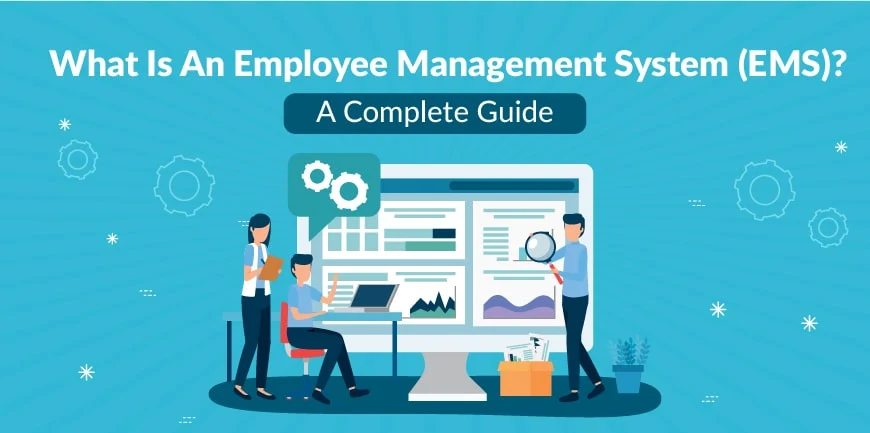
10 Key Components of Staffing: Everything You Need to Know
28/04/2025
What is Contract Labour Regulation and Abolition (CLRA)?
28/04/2025- What Is an Employee Management System? (Meaning & Definition)
- Why Is an Employee Management System Important?
- What Are the Benefits of an Employee Management System?
- How Does an Employee Management System Work?
- What Are the Key Features of an Employee Management System?
- What Are the Challenges in Managing Employees Without a System?
- What Are the Best Practices for Implementing an Employee Management System?
- What Are the Use Cases and Examples of Employee Management Systems?
- Frequently Asked Questions (FAQs)
The workforce engagement has plummeted to 19% in 2025 which was 24% in 2024 as per the Economic Times. One of the primary reasons for this drop is the lack of an effective employee management system. If a company has a considerable workforce and all the HR activities are performed manually, then the situation is bound to get challenging as errors increase leading to employee dissatisfaction and increased retention rates. Let’s take a deep dive and understand the various aspects of the employee management system and gain insights on how it can be implemented in the best possible way.
What Is an Employee Management System? (Meaning & Definition)
The employee management system meaning is quite simple, and it states that ” A sophisticated tool designed specifically to streamline various employee management activities under a single unified digital platform”. The main purpose of an employee management system is to improve operational efficiency and employee satisfaction.
An HR employee management system acts as a centralised hub for carrying out an array of tasks related to employee lifecycle- from onboarding and payroll to performance evaluation and appraisal. Earlier, employee management was done manually creating a huge burden for the HR team leading to numerous errors and delays.
With the introduction of an employee management system, a revolution has taken place, where most tasks are automated and the HR team can verify and validate the outcomes in real-time, creating a seamless experience for employees and HR executives.
Why Is an Employee Management System Important?
For any business to thrive in this volatile market, a strong workforce coupled with cutting-edge technology makes all the difference. As HR teams are loaded with numerous responsibilities, employee engagement may not be that effective which can result in dissatisfaction and increased attrition rates.
To overcome this, organisations started implementing an employee management system and it has proved to be a boon in ensuring maximum employee engagement and reducing the burdens of HR to a large extent.
The key employee management system features include:
- Employee Data Management
- Attendance and time management
- Payroll management
- Leave Management
- Benefits Administration
- Onboarding and Offboarding
- Employee Self-Service
- Workforce Planning
- Document Management
- Performance Management
- Training and Development
- Career Planning
- Compliance Assurance
- Reporting and Analytics
In the current business landscape, companies that utilise employee management systems effectively gain a competitive edge since employee engagement directly impacts profits and brand reputation.
What Are the Benefits of an Employee Management System?
The key benefits of employee management system include:
1. Creates business excellence
The introduction of employee management system has created a paradigm shift in how companies are navigating through the complex frameworks of business administration. EMS has acted as a catalyst in creating business excellence where both employer and employees are reaping mutual benefits such as higher profit, better brand value, higher employee satisfaction and retention, increased trust, and many more.
2. Enhanced workforce management
For companies with a large workforce, managing employee tasks from onboarding to offboarding through traditional methods is impossible. With EMS, you have a central hub where all the employee engagement activities can be carried out seamlessly and simultaneously with minimal human intervention.
3. Simplified HR processes
An HR employee management system simplifies HR processes like onboarding, attendance, leave approval, payroll, appraisal, grievance reporting, performance analysis, sharing updates of company activities, etc. Also, employee data will be stored securely in one place which can be retrieved anytime for analysis and compliance reporting.
4. Improved productivity and employee engagement
Through an employee database management system, both employees and management can track their tasks and productivity in real time. This will help employees and managers make better plans to improve productivity by fixing discrepancies and streamlining the workflow. Additionally, employees can make use of the EMS to apply or cancel their leaves, download payslips, file income tax returns, update employee information, etc., in one place leading to better employee engagement.
5. Ensures compliance
Through EMS, employee data and records are safely stored in a single database and can be retrieved at any time. As per legal requirements, we need to submit audit reports consisting of accurate employee data to relevant authorities to prove compliance. With an employee database management system, this task can easily be accomplished within minutes.
How Does an Employee Management System Work?
Employee management system automates and optimises most HR tasks with the help of software applications integrated under a single database. From recruitment to offboarding, EMS acts as a central hub to carry out all employee-related activities with minimal human intervention. Here is a breakdown of certain activities performed by an EMS.
1. Workforce scheduling and forecasting
EMS helps the HR team to get a forecast of the number of employees required to perform a particular task. Once the employees are onboarded, the manager will take of scheduling the work according to the priorities set by the stakeholders through EMS.
2. Payroll Administration
Employee payroll management system automates payroll activities like gross salary calculations, deductions, payslip generation, and filing tax returns, etc. The automated payroll system will reduce errors and assist the HR team in completing the salary disbursal on time.
3. Tracking Attendance and productivity
EMS has an employee attendance management system function that tracks working hours, log-in and log-out, productive time, idle time, and shift management. The EMS also has an employee leave management system where employees can apply for leave, withdraw leaves, know the status of their leave approval, holiday calendar, etc. This data is used for payroll administration and compliance.
Additionally, the productivity data will be used for analysis of performance, fixing gaps to improve performance, make informed decisions on appraisal and promotion. An EMS offers transparency allowing both employers and employees to prove their case when it comes to giving a final verdict on the yearly performance.
What Are the Key Features of an Employee Management System?
The key employee management system features include:
- Employee Database Management: EMS has a sophisticated employee database management system that stores and manages all active employee data including name, address, job designation, department, employee ID, emergency phone number, etc.
- Time and Attendance Management: EMS has a built-in employee attendance management system that automatically records sign-in and sign-out time, total hours worked, break times, idle times, etc.
- Payroll Management: EMS has another feature called the employee payroll management system that automates payroll activities like salary calculations, tax deductions, payslip generation, etc.
- Employee Self-Service Portal: It allows employees to access their details, get notifications, and track requests.
- Leave management: The employee leave management system features enable employees to apply for leave, check available leaves, holiday calendar, leave cancellation, etc.
- Performance management: Through EMS, employers can get a clear understanding of the employee’s performance, contribution towards business goals, and areas of improvement. The managers can review the performance and decide about the appraisal in a transparent manner.
What Are the Challenges in Managing Employees Without a System?
Without an employee skill management system, managing the workforce is nearly impossible in the current business landscape. The challenges of managing employees without an employee management system include:
1. Low employee engagement
Communicating with the employees through an EMS is seamless and more effective, whereas operating without it can result in low employee engagement. Employees without EMS must depend entirely on the HR team’s response to requests which can create frustration leading to lower productivity and dissatisfaction.
2. Loss of revenue
The advantages of the employee management system are plenty as they reduce costs and increase overall efficiency. Without an EMS, a lot of errors can occur during the payroll process, attendance and leave management, appraisal decisions, etc., Fixing these issues can lead to increased costs which can eat into the profits and create a loss of revenue for the companies.
3. Difficulty in making informed decisions
In the current business era, most decisions taken by organisations are data-driven. Without an EMS, making decisions is like playing Russian Roulette, chances of making a blunder are very high.
4. Administrative Inefficiency
Without an EMS, the HR team is bound to do most activities like payroll management, attendance, tax filing, onboarding and offboarding, etc., manually. This can be both time-consuming and require a lot of resources leading to administrative inefficiency and will affect compliance goals adversely.
What Are the Best Practices for Implementing an Employee Management System?
1. Understanding the future scope of employee management system
Before implementing EMS, companies must understand why it is essential to implement an employee management system. Gather employee and HR team’s feedback beforehand about the requirements and current pain points. It will help in making informed decisions on finalising the employee management system features for best utilisation. Additionally, invest in training employees and the HR team on how to use and manage EMS effectively.
2. Choosing the best employee management system
Making the right choice of employee management system solution is crucial as the features offered by the EMS software play a crucial role in creating maximum employee engagement. The key factors for choosing the best employee management system include user-friendliness, scalability, compliance with industry standards, efficient customer support system, flexibility, etc.
3. Engaging Employees
The Companies must encourage employees to make the best use of EMS to improve their productivity, and performance, and track their career progress. Instil a positive work culture where employees make the EMS their ally rather than an obligation.
4. Continuous monitoring and evaluation of the effectiveness of EMS
The company must not think that its job is done by just rolling out the best employee management system and expect maximum employee engagement. The EMS must be reviewed and evaluated for effectiveness every quarter and if there are gaps found, mitigation strategies must be implemented proactively. Involve employees and the HR team in making improvements to the existing EMS and add new features that ensure maximum employee engagement and provide strategic insights for improving business outcomes.
What Are the Use Cases and Examples of Employee Management Systems?
The key use cases of an employee management system are:
- Job posting and tracking application: The HR employee management system has built-in features to automate the process of posting job vacancies, application tracking, and conducting the interview process.
- Time and attendance: EMS with an employee attendance management system can automatically track working hours including idle time, break, sign-in and sign-out time.
- Payroll management and benefits administration: EMS with a built-in employee payroll management system feature will automate the process of calculating gross salary, deductions and rollout payments on time.
Here are the examples of top employee management system solutions preferred by most companies:
- Zoho People
- GreytHR
- BambooHR
- HROne
- Keka HR
Frequently Asked Questions (FAQs)
1. What is an Employee Management System (EMS)?
An Employee Management System (EMS) is a digital software platform installed by companies to manage and automate most HR activities to improve employee engagement and reduce errors related to payroll, attendance and leave management, compliance management, etc.
2. What are the main modules of an employee management system?
The main modules of an HR employee management system include HR Database management, payroll and benefits administrations, onboarding and offboarding, attendance and leave management, performance management, etc.
3. How does an EMS improve HR efficiency?
Does An EMS improve HR efficiency by automating and streamlining most HR activities like onboarding, payroll management, attendance and leave management, performance management, etc? An EMS helps the HR team to focus on strategic initiatives rather than spend all their time in administrative tasks leading to more productivity and maximum employee engagement.
4. Does an EMS integrate with payroll software?
Yes, most employee engagement systems are equipped with the option of integrating with payroll software. The EMS will feed the employee data to payroll software which in turn performs payroll tasks like salary calculations, salary disbursement and tax withholdings.
5. What are the types of employee management systems?
The different types of employee management systems include Human Capital Management (HCM), Human Resource Information Systems (HRIS), Human Resource Management System (HRMS), Employee Self-Service (ESS), etc.
6. What are the compliance benefits of using an EMS?
The compliance benefits of using an EMS are preventing legal complications and penalties, providing accurate employee data for better compliance, and demonstrating commitment towards environmental compliance.
7. How much does it cost to implement an EMS?
The cost of implementing an EMS varies based on numerous factors such as the size and type of organisation, features required, maintenance fees, licenses and certifications of companies, in-house implementation or done third party, etc.
8. How to choose the best employee management system?
To choose the best employee management system, the company must weigh in factors such as business needs, the right EMS software solution, scalability, number of features, budget, etc. Once these are established, making the right choice of EMS will be much easier.
9. What is the future scope of employee management systems?
The future scope of employee management systems is very bright as companies that offer EMS solutions continuously look to make improvements like offering a more personalised experience and better support to remote and hybrid models, enhanced data security and compliance, and many more.
Contact Us For Business Enquiry

Rajkumar Shanmugam
Rajkumar Shanmugam is the Head of HR at ALP Consulting, bringing over 19 years of comprehensive HR leadership experience across India and international markets. His expertise spans talent acquisition, employee relations, performance management, compliance, and HR transformation. Rajkumar has a proven track record of driving people-centric initiatives, enhancing workplace culture, and aligning HR strategy with business goals. With extensive experience in US staffing operations and global mobility, he continues to lead organizational excellence through innovation and employee engagement.




